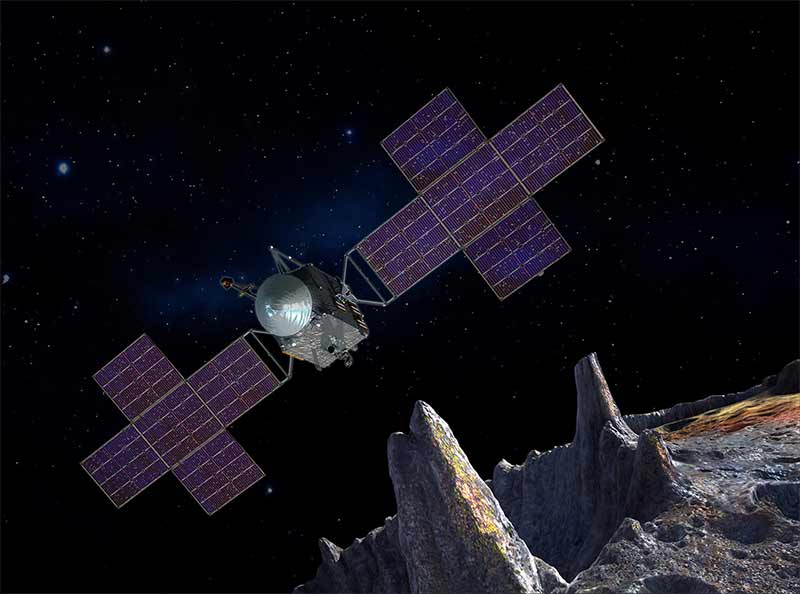- World
- Nov 02
Hubble gives a closer look at 16 Psyche
A study has revealed that the asteroid 16 Psyche, one of the most massive objects in the main asteroid belt orbiting between Mars and Jupiter, could be totally made of iron and nickel. Experts have estimated it will be worth over $10,000 quadrillion, more than the entire economy of Earth.
16 Psyche
One of the most intriguing targets in the main asteroid belt, 16 Psyche is a giant metal asteroid, about three times farther away from the Sun than is the Earth. Its average diameter is about 140 miles (226 kilometers) — about one-sixteenth the diameter of Earth’s Moon.
It is orbiting between Mars and Jupiter.
What are the key findings of the study?
The scientists observed the asteroid at ultraviolet (UV) wavelengths (170–310 nm) using the Space Telescope Imaging Spectrograph on the Hubble Space Telescope during two separate observations.
The study authored by Southwest Research Institute planetary scientist Tracy Becker discusses several new views of the asteroid 16 Psyche, including the first ultraviolet observations. The study was published in The Planetary Science Journal.
“We’ve seen meteorites that are mostly metal, but Psyche could be unique in that it might be an asteroid that is totally made of iron and nickel. Earth has a metal core, a mantle and crust. It’s possible that as a Psyche protoplanet was forming, it was struck by another object in our solar system and lost its mantle and crust,” Becker said.
Becker observed the asteroid at two specific points in its rotation to view both sides of Psyche completely and delineate as much as possible from observing the surface at ultraviolet wavelengths.
The study comes as NASA is preparing to launch the spacecraft Psyche, which will travel to the asteroid as part of an effort to understand the origin of planetary cores.
Psyche mission
The Psyche mission was chosen by NASA on January 4, 2017 as one of two missions for the agency’s Discovery Program, a series of relatively low-cost missions to solar system targets.
The mission is currently targeted to launch in 2022 on a Falcon Heavy rocket. It is expected to reach the asteroid in 2026. The total cost for NASA to launch Psyche and the secondary payloads is approximately $117 million.
Deep within rocky, terrestrial planets — including Earth — scientists infer the presence of metallic cores, but these lie unreachable far below the rocky mantles and crusts. Because we cannot see or measure Earth’s core directly, Psyche offers a unique window into the history of collisions and accretion that created terrestrial planets.
Scientists wonder whether Psyche could be an exposed core of an early planet that could have been as large as Mars, but which lost its rocky outer layers due to a number of violent collisions billions of years ago.
It will help to understand how planets and other bodies separated into their layers — including cores, mantles and crusts.
Objectives of the mission are to:
• Determine whether Psyche is a core, or if it is unmelted material.
• Determine the relative ages of regions of Psyche’s surface.
• Determine whether small metal bodies incorporate the same light elements as are expected in the Earth’s high-pressure core.
• Determine whether Psyche was formed under conditions more oxidizing or more reducing than Earth’s core.
• Characterise Psyche’s topography.
It will test a sophisticated new laser communication technology that encodes data in photons (rather than radio waves) to communicate between a probe in deep space and Earth. Using light instead of radio allows the spacecraft to communicate more data in a given amount of time.
The mission is led by Arizona State University.
“16 Psyche is the only known object of its kind in the solar system, and this is the only way humans will ever visit a core. We learn about inner space by visiting outer space.” Lindy Elkins-Tanton, mission’s principal investigator, said.
It has been calculated that the iron alone in 16 Psyche would be worth more than $10,000 quadrillion.
However, Elkins-Tanton adds that we cannot bring Psyche back to Earth as there is no technology to do that.
The asteroid was named after the nymph Psyche, who married Cupid but was put to death by Venus. Psyche was discovered by the Italian astronomer Annibale de Gasparis on March 17, 1852.
Manorama Yearbook app is now available on Google Play Store and iOS App Store


